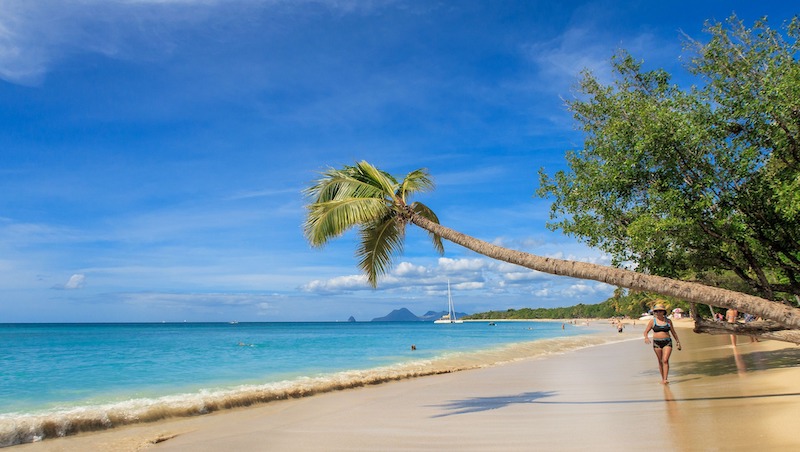Martinique
Martinique provides a brilliant blend of local culture with the French influence from yesteryear. Lush gardens, stunning seas and friendly locals await.
Martinique travel guide
Almost 2 decades ago, Martinique's landmark, the Mont Pelee volcano, erupted, destroying the island’s capital, St-Pierre, as well as much of the magnificent surroundings. But the island has resurrected itself as best it could and visitors are flocking here one again to enjoy Martinique’s magnificent rainforest in the interior, breathtaking beaches and natural surroundings. The new capital town of Fort-de-France and the town of Le Lamentin both offer a bustling lifestyle with superb Caribbean, European and Creole dining and entertainment offerings.
Martinique is a French overseas territory, an island with exceptional natural beauty and several historic landmarks that date back to when the island was first colonized. Its capital, Fort-de-France, has been called ‘The Paris of the Caribbean’ because it is such a sophisticated resort town with a stunning beach promenade and excellent modern facilities.
The island itself offers a wide selection of fun activities aside from lazing on a choice of beautiful sandy beaches, including hiking up Mount Pelee, visiting the Musee de la Pagerie and the Anse Cafard Slave Memorial, enjoying world-class sailing and exciting water sports opportunities.

The sandy beaches of Martinique are sun-kissed and stunning.
Best time to visit: For perfect weather and less expensive vacation options, visit in May. Peak season is from December to April.
Best Area for Sightseeing: The entire island is a delight to explore. See Things to do in Martinique for some inspiration.
Shopping in Martinique: Fashion fresh off the French catwalks is available in Fort-de-France along Rue Victor Hugo. In the capital, you can also pick up stunning local handicrafts, Creole jewellery and more. Scour the markets including Grand Marche for local treasures, fresh produce, spices and rum.
Food & Restaurants in Martinique: The island’s cuisine is unique and delicious, a stunning blend of French, African and Caribbean influences and products. Of course, the seafood is superb, and you’ll also find fine French eateries to dine in. At the Fruit and Vegetable Market in the capital you can buy stunning fresh produce and enjoy the local atmosphere.
Nightlife: Beach clubs offer island music and Jazz, and bars are aplenty on the beaches and in the towns. Of course, the resorts also offer their own taste of night-time entertainment.
Beaches: You’ll find stunning little beaches at Pointe du Bout, where most of the island’s larger resorts are situated. Or head to palm-lined Diamond Beach, a pretty, popular spot. A little further is the village of Sainte-Anne, home to 2 of the best beaches in Martinique, Cap Chevalier and Plage de Salines. There are also 2 black sand beaches, Le Carbet Beach, which offers stunning views of Mount Pelee, and Anse Noire. On the south coast is Anse Mabouyas and in the north is Anse Ceron, both renowned for superb snorkelling opportunities.
Things to do in Martinique:
- Enjoy hiking on coastal rainforest trails between Grande Riviere and Le Precheuer.
- Climb iconic Mount Pelee.
- Explore Fort-de-France to see historic Fort Saint Louis, a smattering of museums and cathedrals.
- Discover the volcano museum in St-Pierre dedicated to the eruption in 1902 that killed all but one of the island’s residents.
- Explore the Musee de la Pagerie, a former sugar estate where Empress Josephine, wife of Napoleon Bonaparte, was born.
- Visit the Anse Cafard Slave Memorial, 20 statues facing out to sea in honor of 20 who died in a slave ship that sunk in 1835.
- Visit the exceptional Bibliothèque Schoelcher, a library built in Paris in 1889 that was taken apart and shipped to Martinique where it was reassembled.
- See Fort St Louis, originally built in 1640.
- Head to the village of Le Carbet, where Christopher Columbus landed in 1502 on his fourth and final visit to the Caribbean.
- Enjoy superb diving opportunities at Diamond Rock, 3km off the island’s southern coastline.
Best way to get around: Use the island’s public transport options – vans and Taxis Collectifs, large Mercedes-Benz vehicles that are affordable and easily accessible. Otherwise, rent a car.
